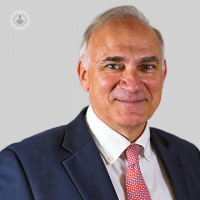Robotic surgery for gynaecological care
Written by:Robotic surgery is a pioneering surgical technique that allows minimally-invasive procedures to be carried out. Mr Angus McIndoe, an expert obstetrician and gynaecologist, was one of the first surgeons in this field to perform a wide range of procedures using robotic surgery, which is offered for numerous procedures at The McIndoe Centre.

What is robotic surgery?
Robotic surgery is an innovative approach to perform complex surgeries, with the use of a robot, which is called the Da Vinci Robot. This robot, together with a surgeon, is able to perform minimally invasive (keyhole) surgery with an extremely high level of precision. The robot carries out procedures through very small incisions. The robot is controlled by the surgeon, and their movements are scaled so that the movements are accurate, with no hand tremors. Due to the minimally-invasive nature of robot-assisted surgeries, patient recovery is less painful, quicker and they are able to return to normal activities sooner.
Why use robotic surgery?
Advantages for patients:
- Shorter stay in hospital
- Less pain
- Quicker recovery
- Lower complication rate
- Less scarring (internally)
Advantages for the surgeon:
- Instruments are more flexible and intuitive
- The robot allows high-definition 3D vision
- Surgical procedures are less tiring than in regular surgery
- The robot allows precise movements and is able to duplicate open surgical techniques
What procedures can be carried out using robotic surgery?
- Removing fibroids
- Myomectomy (procedure to remove uterine fibroids)
- Vaginal prolapse repair
- Endometriosis surgery
- Hysterectomy
What happens after having robotic surgery?
With robotic surgery, studies show that patients are able to leave hospital sooner and require less pain relief. There is less pain because the robotic arms do not place pressure on the channels going into the abdomen, which usually is the site of pain after surgery.
What makes robotic surgery so comfortable for the surgeon?
Using the Da Vinci robot requires the surgeon to be seated throughout the procedure, and is in a comfortable position, meaning the surgeon will tire less quickly. The positioning of the hands on the robot are placed in such a way that it feels like the surgical instruments inside the patient’s body are in the surgeon’s own hands. In addition, as the surgeon’s hand movements are mimicked so precisely by the robot, surgery feels very intuitive. In comparison, laparoscopic surgery can feel awkward as movements of the instrument are counter-intuitive.
If you would like to find out more, make an appointment here.


